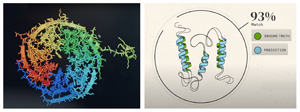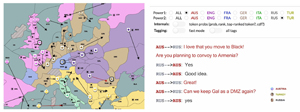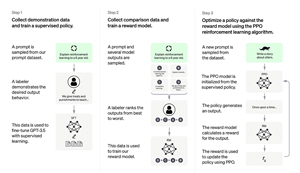How-To
Researchers Evaluate the Top Four AI Stories of 2022
Three AI experts weigh in on top developments ranging from playing master-level Diplomacy to predicting protein structures.
- By Pure AI Editors
- 01/05/2023
The Pure AI editors surveyed our three technical contributing editors for their opinions about significant developments in artificial intelligence (AI) during 2022. According to our experts, the top four developments during 2022 were:
- The release of the DALL-E 2 system to generate artificial images.
- The development of the AlphaFold system to predict protein structure.
- The development of the Cicero system to play master-level Diplomacy.
- The release of ChatGPT to answer arbitrary text-based questions.
The criteria for an important development are somewhat subjective and include how much publicity the development generated and the potential impact. The Pure AI technical experts work at research departments of three different, very large, tech companies.
In order to allow our experts to freely express their opinions, they are anonymous. All three experts hold doctorates and all three work in a hybrid role where they conduct theoretical research and develop deep learning systems.
1. The DALL-E 2 System
In April 2022, the OpenAI company announced DALL-E 2, a deep learning image generation model. DALL-E 2 is a successor to the original DALL-E released in 2021. The name of the system, DALL-E, is derived from abstract artist Salvador Dali (1904-1989) and animated film "WALL-E" (2008).
 [Click on image for larger view.] Figure 1: Images Generated by DALL-E (left) and DALL-E 2 (right) (source: openai.com/dall-e-2/).
[Click on image for larger view.] Figure 1: Images Generated by DALL-E (left) and DALL-E 2 (right) (source: openai.com/dall-e-2/).
Users input a natural language phrase/prompt such as, "A painting of a fox sitting in a field at sunrise in the style of Claude Monet" (see Figure 1). The DALL-E 2 system analyzes the prompt using a deep language model named GPT-2 or GPT-3 and gains a deep latent understanding of the prompt, in a way that isn't fully understood. The latent representation is then applied to an image generation technique called CLIP (Contrastive Language Image Pretraining) and a diffusion model.
One of our Pure AI experts commented, "The Dall-E 2 system received a lot of media attention, mostly because the problem is easy to understand and the results are easy to interpret." All three experts echoed an opinion similar to the idea that the practical impact and potential for revenue generation is limited.
2. The AlphaFold System
In July 2022, DeepMind announced the release of predictions for the shape of every single protein in the human body, as well as for the proteins of 20 additional organisms that scientists rely on for their research. Proteins are the basic building blocks of all life. Proteins are made of amino acids, but the difficult part of understanding protein structure is their three-dimensional shape.
 [Click on image for larger view.] Figure 2: The AlphaFold System (source: deepmind.com/research/highlighted-research/alphafold).
[Click on image for larger view.] Figure 2: The AlphaFold System (source: deepmind.com/research/highlighted-research/alphafold).
Attraction and repulsion forces between the 20 different types of amino acids cause the string to form complex shapes, forming the intricate curls, loops and pleats. The protein-folding problem has been studied for decades -- finding a way to determine a protein's three-dimensional structure just from its sequence of amino acids.
DeepMind is a subsidiary of Alphabet (Google) and is based in London.
All three of the Pure AI experts were impressed with AlphaFold. "AlphaFold is a significant breakthrough in computational biology," said one. "It's quite possible that AlpaFold will lead to important advances in biology."
3. The Cicero System
In November 2022, Meta (Facebook) Research announced the Cicero system. Cicero is an AI agent that can beat humans at the strategy board game Diplomacy (Hasbro Inc.) Unlike games like chess, Diplomacy is an ambiguous and social game that requires cooperation and negotiation with other players.
 [Click on image for larger view.] Figure 3: The Cicero System (source: ai.facebook.com/research/cicero/diplomacy/).
[Click on image for larger view.] Figure 3: The Cicero System (source: ai.facebook.com/research/cicero/diplomacy/).
The system is named Cicero after the ancient Roman statesman. To gain its negotiating skills, Cicero learned a large language model component on text scraped from the internet and also transcripts of 40,000 human-played games of Diplomacy. The system also developed a tactical component that can look at the state of the game and predict how other players would behave.
The Pure AI technical experts had mixed opinions about the relative importance of the Cicero system. Two experts were quite impressed with the success of the system in a challenging environment. One mildly skeptical expert said, "It's not clear to me if the Cicero system can generalize to problem scenarios that have great ambiguity, or if Cicero is a finely tuned system that can handle a very narrow problem."
4. The ChatGPT System
ChatGPT (Chat - Generative Pretrained Transformer) is a chatbot launched by OpenAI in November 2022. A user can submit a natural language question, get an answer and continue the conversation. The dialogue format makes it possible for ChatGPT to answer follow-up questions, admit its mistakes, challenge incorrect premises and reject inappropriate requests.
 [Click on image for larger view.] Figure 4: The ChatGPT System (source: openai.com/blog/chatgpt/).
[Click on image for larger view.] Figure 4: The ChatGPT System (source: openai.com/blog/chatgpt/).
ChatGPT was fine-tuned from a model based on the GPT-3.5 series language model, which finished training in early 2022.
Our Pure AI experts were mostly skeptical about ChatGPT. One expert commented: "It's difficult to imagine a use-case for ChatGPT. There's essentially no control over the source of the information returned by ChatGPT. I'm surprised that ChatGPT has received the amount of media attention we've seen."
One thing all our experts agreed upon was that 2022 was a momentous year for AI and they're expecting even greater things in 2023.